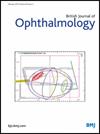Quantifying the correlation of ocular manifestations and macular pigment optical density in albinism: a prospective cross-sectional study.
IF 3.5
2区 医学
Q1 OPHTHALMOLOGY
引用次数: 0
Abstract
AIMS To demonstrate the presence of macular pigments in patients with albinism using colour perimetry and to evaluate the relationship between macular pigment optical density (MPOD) and ocular findings. METHODS 50 patients were included. Best-corrected visual acuities (BCVAs) were measured at 2 meters (Early Treatment Diabetic Retinopathy Study charts) and recorded as logMAR. Iris transillumination defect was graded as 5 on a 5-point scale. The severity of foveal hypoplasia was graded as 4 on a 4-point scale using optical coherence tomography. After fixating on a light source 3 cm away for 10 seconds, the time taken to read three letters from the BCVA row was measured as photostress recovery time. MPOD and macular pigment mean defect were measured quantitatively using colour perimetry. RESULTS Median BCVA was 0.8 logMAR. Median photostress recovery time was 8 seconds. MPOD measurements were acquired from all eyes except two eyes (4%). Median MPOD and macular pigment mean defect were 0.63 decibel (dB) and 4.34 dB, respectively. There was a statistically significant negative correlation between MPOD and BCVA-logMAR, and a positive correlation between macular pigment mean defect and BCVA-logMAR. No statistically significant correlation was found between grade of iris transillumination defect, photostress recovery time and grade of foveal hypoplasia. CONCLUSIONS Patients with albinism have macular pigments, and these can be determined by colour perimetry. Eyes with higher macular pigments tend to have better visual acuity. This finding suggests that supplementation with retinal carotenoids could be a promising therapeutic approach for albinism, as it may increase macular pigment density, leading to improved visual acuity.量化白化病眼部表现与黄斑色素光密度的相关性:一项前瞻性横断面研究。
目的利用彩色透视法证实白化病患者黄斑色素的存在,并评价黄斑色素光密度(MPOD)与眼部表现之间的关系。方法纳入50例患者。在2米处测量最佳矫正视力(BCVAs)(早期治疗糖尿病视网膜病变研究图表)并记录logMAR。虹膜透照缺陷在5分制中分为5级。采用光学相干断层扫描将中央凹发育不全的严重程度分为4级(4分制)。注视3厘米外的光源10秒后,从BCVA行读取三个字母所需的时间作为光应力恢复时间。采用颜色视界法定量测定MPOD和黄斑色素平均缺损。结果中位BCVA为0.8 logMAR。中位光应力恢复时间为8秒。除两只眼(4%)外,所有眼均进行了MPOD测量。中位MPOD和黄斑色素平均缺损分别为0.63分贝和4.34分贝。MPOD与BCVA-logMAR呈显著负相关,黄斑色素平均缺损与BCVA-logMAR呈正相关。虹膜透照缺损程度、光敏恢复时间与中央凹发育不全程度无统计学意义。结论白化病患者存在黄斑色素,可通过颜色透视法确定。黄斑色素越高的眼睛视力越好。这一发现表明,补充视网膜类胡萝卜素可能是白化病的一种有希望的治疗方法,因为它可能增加黄斑色素密度,从而改善视力。
本文章由计算机程序翻译,如有差异,请以英文原文为准。
求助全文
约1分钟内获得全文
求助全文
来源期刊
CiteScore
10.30
自引率
2.40%
发文量
213
审稿时长
3-6 weeks
期刊介绍:
The British Journal of Ophthalmology (BJO) is an international peer-reviewed journal for ophthalmologists and visual science specialists. BJO publishes clinical investigations, clinical observations, and clinically relevant laboratory investigations related to ophthalmology. It also provides major reviews and also publishes manuscripts covering regional issues in a global context.

 求助内容:
求助内容: 应助结果提醒方式:
应助结果提醒方式:


